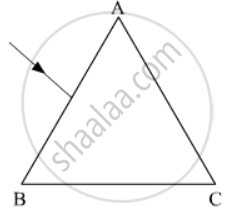Advertisements
Advertisements
Question
Make the correct choices for each of the following :
Total Internal reflection takes place when
(where ∠i = angle of incidence, ∠r = angle of refraction, ∠C = critical angle)
Options
Light is going from glass to air and ∠I < ∠C
Light is going from air to glss and ∠i < ∠C
Light is going from glass to air and ∠i > ∠C
Light is going from air to glss and ∠i > ∠C
Light is going from glass to air and ∠i = ∠r
Solution
Light is going from glass to air and ∠i > ∠C
APPEARS IN
RELATED QUESTIONS
The figure shows a ray of light falling normally on the face AB of an equilateral glass prism having refractive index`3/2`, placed in water of refractive index `4/3`.Will this ray suffer total internal reflection on striking the face AC? Justify your answer.

State the relation between the critical angle and the absolute refractive index of a medium.
Draw diagram to illustrate the total internal reflection.
Images formed by totally reflecting prisms are brighter than the image formed by ordinary reflected light, why?
A ray of light is incident on a glass surface at an angle of 50° with the corresponding angle of refraction 30°. Find the value of the R.I. of glass.
A spherical marble, of refractive index 1.5 and curvature 1.5 cm, contains a tiny air bubble at its centre. Where will it appear when seen from outside?
Choose the correct option.
Angles of deviation for extreme colours are given for different prisms. Select the one having maximum dispersive power of its material.
The angle of minimum deviation produced by a thin glass prism in air is 'δ'. If that prism is immersed in water, the angle of minimum deviation will be ______.
( aμg = refractive index of glass w.r.t, air aμw = refractive index of water w.r.t. air)
Write any two uses of total internal reflection.
State two differences between normal reflection and total internal reflection.
